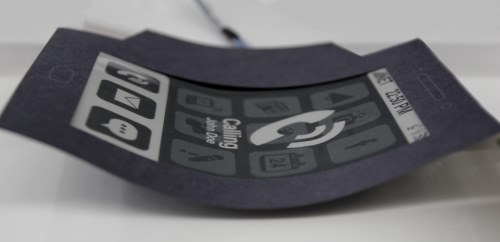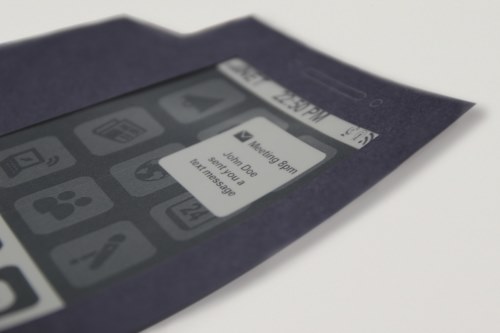Our smartphones have a variety of different notification options. We can choose from musical tones, radio tunes, vibrations, silent functions, and even chicken noises these days. When a user puts a mobile device on silent or vibrate mode, there is really no way for them to know if they are being called or messaged.

The MorePhone curls and bends when a user recieves a call or alert. (Image via Queens University Human Media Lab)
Researchers at the Queens University Human Media Lab in Canada have designed the “MorePhone” that can morph into a shape to give users a visual signal of an incoming text, call, or e-mail.
“Users are familiar with hearing their phone ring or feeling it vibrate in silent mode. One of the problems with current silent forms of notification is that users often miss notifications when not holding their phone. With MorePhone, they can leave their smartphone on the table and observe visual shape changes when someone is trying to contact them,” said Roel Vertegaal, director of the Human Media Lab at Queen’s University.
The smartphone is made of a thin, flexible, electrophoretic display made by British company, Plastic Logic. Electrophoretic displays form visible images by rearranging pigment particles using an applied electric field. Under the display lie shape memory alloy wires that contract when the phone needs to notify a user.
Using this kind of technology, the MorePhone can curl up its entire body, or up to three individual corners and users can customize the curls. For example, the users can set the bottom right corner to fold up when they receive a text message, or have corners repeatedly fold to express urgency.

User programs one corner to fold up when recieving a text message. (Image via Queens University Human Media Lab)
Dr. Vertegaal is also responsible for the development of the PaperPhone and PaperTab, unveiled in 2011. The PaperPhone is similar to an iPhone, but made of a thin, flexible ink display.
Watch the demonstration of the MorePhone in the video below.
The MorePhone was developed by Dr. Vertegaal and two School of Computing students, Antonio Gomes and Andrea Nesbitt. They expect that the new technology could be available for consumer purchase within the next five to 10 years.
Learn more about the Queens University Human Media Lab.
Advertisement
Learn more about Electronic Products Magazine





